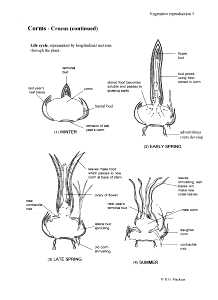
Reproduction

When you think of plant reproduction what do you think of? Most people think of pollination and bees and what not. Well they wouldn’t be wrong. The reason that this is the first thing to pop into our minds is because the majority of plants we interact with are Angiosperm. This is because Angiosperms are efficient at protecting and spreading their seeds.
Corms
The seed of an Angiosperm house the embryo.
These are protected by a carpel that protects against cold weather
or drying out. This carpel is the fruit that many organisms such as
mice, birds, and even us, eat. The organism ingests the seeds and
later spread them out in their feces. So when you look at it this
way the fruit (such as an apple or peach) is just a large ovary.
 But, as you might have guessed Autumn
Crocus does not produce any edible fruit, quite the opposite. So how
do they reproduce? The Autumn Crocus has become so adapted to its
environment that it no longer requires sexual reproduction and
therefore can reproduce asexually via corms. Corms are much a like a
bulb except instead of having layers they are solid on the inside.
They produce offshoots of themselves and since only one parent
plant is needed the daughter plants are exactly identical to the
parent. This is called vegetative reproduction. A smaller corm
called a cormel grows off
the parent and matures to produce its own flower. In planting, the
cormels can be cut off and replanted to start a new bed.
But, as you might have guessed Autumn
Crocus does not produce any edible fruit, quite the opposite. So how
do they reproduce? The Autumn Crocus has become so adapted to its
environment that it no longer requires sexual reproduction and
therefore can reproduce asexually via corms. Corms are much a like a
bulb except instead of having layers they are solid on the inside.
They produce offshoots of themselves and since only one parent
plant is needed the daughter plants are exactly identical to the
parent. This is called vegetative reproduction. A smaller corm
called a cormel grows off
the parent and matures to produce its own flower. In planting, the
cormels can be cut off and replanted to start a new bed.
Sexual Reproduction
What happens if the environment changes?
The Autumn Crocus still has
its flower containing the pistil and stamen. When it is pressured
the flower can revert to sexual reproduction to ensure the survival
of its species. Nectar is contained within the cup of the flower,
when bees come down to collect it their legs, body, and wings brush
against the stamen and get covered in pollen. When the bee flies to
the next flower the pollen can be shaken off onto the stigma where
it travels down the style to the ovary where fertilization occurs.
Go to Classification to learn more about Angiosperms.
Return to Home Page. Go to MultipleOrganisms.net